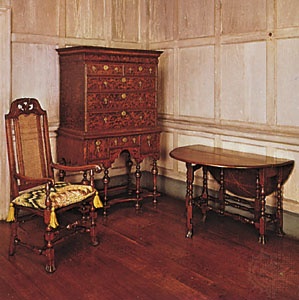William and Mary style
 style of decorative arts so named during the reign (1689–1702) of William III and Mary II of England. When William came to the English throne from the house of Orange, he encouraged many Dutch artisans to follow him. In addition to these craftsmen, Huguenot refugees from France worked in the cabinetmakers' and designers' shops of London during this time. Their influence was strongly felt under William, who was partial to the florid effects of French style.
style of decorative arts so named during the reign (1689–1702) of William III and Mary II of England. When William came to the English throne from the house of Orange, he encouraged many Dutch artisans to follow him. In addition to these craftsmen, Huguenot refugees from France worked in the cabinetmakers' and designers' shops of London during this time. Their influence was strongly felt under William, who was partial to the florid effects of French style.The excesses of the heavy English Restoration mode, nonetheless, were tempered by a plainer fashion in decoration. A new, intimate style of life that created smaller rooms demanded a more modest scale of furniture. Comfort became important too, as attested by the upholstered needlepoint chair seats of the day.
Although the underlying contours of William and Mary furniture are quite simple—emphasizing the vertical line rather than the more horizontal line typical of earlier domestic furnishing—they are embellished with delicate ornament. Marquetry in ivory and coloured woods or metal inlay frequently is found in arabesque patterns resembling seaweed and spiders' webs.
Highboys (highboy) and lowboys (lowboy) are major pieces for the period, and serpentine stretchers and spiral turnings are typical. Walnut superseded the use of oak as the basic wood of English cabinetry during this period, and a number of exotic woods such as acacia and olive, which reached the country via new East–West trade routes, were put to use as veneer and inlays. Japanning, the popular Asian lacquerwork, also remained in vogue.
Characteristic of William and Mary style are the scallop shell, C- and S-scrolls, and the acanthus leaf of classical tradition. Daniel Marot, a Huguenot, was designer general to the royal couple; but his work is overshadowed by the skillful inventions of Gerrit Jensen, the most fashionable furniture designer of his day, whose inspiration seems to have been mainly French.
- heating
- Heating element ceramics
- heat of reaction
- heat pipe
- Heat productivities
- Heat productivities of various rocks
- heat pump
- heatstroke
- heat transfer
- heaven
- Heaven's Gate
- heaves
- Heaviside, Oliver
- heavy ion
- heavy metal
- heavy oil and tar sand
- Heavysege, Charles
- heavy water
- Hebat
- H.E. Bates
- Hebbel, Friedrich
- Hebe
- Hebei
- Heber City
- Heberto Padilla